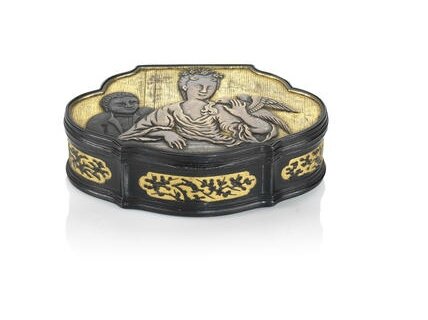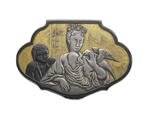A fine and very rare relief-decorated silver-mounted gilt-bronze 'European subject' ruyi-head-shaped snuff box
A fine and very rare relief-decorated silver-mounted gilt-bronze 'European subject' ruyi-head-shaped snuff box, First half of the 18th century. Photo courtesy Bonhams
Elegantly cast in the form of a ruyi-head, one side featuring a metallic-embossed figure of an European lady wearing loose clothing and hair neatly tied in coiffure using a floral wreath, her left hand raised with an exotic bird perched with wings extended, an European gentleman admiring her from the right; the other side showing a farmer working in the fields, his right hand spreading seedlings and left hand holding a sickle, clearing weeds from the field with a jug and scythe beside him, the lobed sides further decorated with four lobed cartouches of birds perched on trees, the inside cover further bearing a scene of two figures seated atop rockworks within an alcove, indulging in a passionate kiss and flanked by a pair of doves. 10.2cm wide; 7cm deep; 3cm high. Estimate HK$ 600,000 - 800,000(€57,000 - 77,000)
This remarkable box is unusual in this Collection because the inspiration is rather more in Dutch than English taste. The Dutch did not, by and large, have a major influence on craftsmanship in Canton, although a number of Dutch points clearly influenced some of the potters creating Export porcelain for Westerners seeking shipments at Canton. However, the style of the clothes and the general feel of the depiction of the elegant foreigners suggest a Dutch design origin in the last decades of the 17th century.
The suggestion of Dutch inspiration raises of course the possibility that this very rare box was influences by designs emanating from Batavia, the permanent Dutch trading entrepot on the north coast of Java since the early 17th century. The technique found on the present lot recalls the type of black-patinated and gilt wares, which some specialists believe were manufactured in Java, following a precedent set by the Japanese who are believed to have produced 'Sawasa-ware' since the 17th century. The Dutch-style boxes are made from copper alloy with gilt relief decoration and black lacquered highlights; in this they differ from the original Japanese 'shakudo', which refers to the copper alloy and gives a visibly different finish. For snuff boxes made by the Japanese for the Export trade, see the sale of Fine Silver and Gold Boxes, Bonhams New Bond Street, 23 November 2011, lots 11 and 12; and for a more general discussion, see De Brujin et al., Sawasa - Japanese Export Art in Black and Gold 1650-1800,Rijksmuseum, Amstersdam, 1998.
English and Dutch box designs continued for many years in the 18th century to share certain characteristics not found in France, notably the high-relief work, chased and repoussé, so popular in both countries in the mid 18th century; see A.Kenneth Snowman, Eighteenth Century Gold Boxes of Europe,p.92.
Bonhams. THE SPEELMAN COLLECTION OF CHINESE 'IMPERIAL TRIBUTE' SNUFF BOXES. Hong Kong. 24 Nov 2013 13:00 CST

/https%3A%2F%2Fprofilepics.canalblog.com%2Fprofilepics%2F1%2F0%2F100183.jpg)
/https%3A%2F%2Fstorage.canalblog.com%2F03%2F02%2F119589%2F96711876_o.jpg)
/https%3A%2F%2Fstorage.canalblog.com%2F11%2F31%2F119589%2F94773502_o.jpg)
/https%3A%2F%2Fstorage.canalblog.com%2F20%2F83%2F119589%2F94772815_o.jpg)
/https%3A%2F%2Fstorage.canalblog.com%2F26%2F72%2F119589%2F75604929_o.jpg)
/https%3A%2F%2Fstorage.canalblog.com%2F59%2F60%2F119589%2F26458628_o.jpg)







/http%3A%2F%2Fstorage.canalblog.com%2F03%2F24%2F119589%2F112365777_o.jpg)
/http%3A%2F%2Fstorage.canalblog.com%2F08%2F84%2F119589%2F128581002_o.jpg)
/http%3A%2F%2Fstorage.canalblog.com%2F44%2F38%2F119589%2F95673344_o.jpg)
/http%3A%2F%2Fstorage.canalblog.com%2F25%2F97%2F119589%2F92786316_o.jpg)